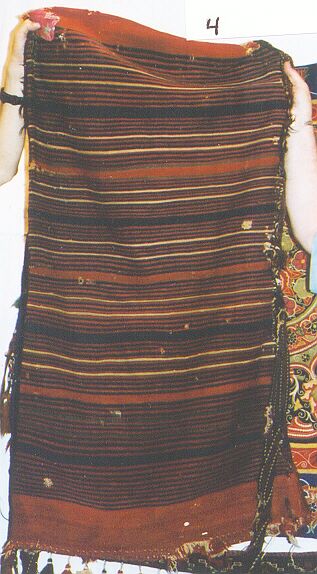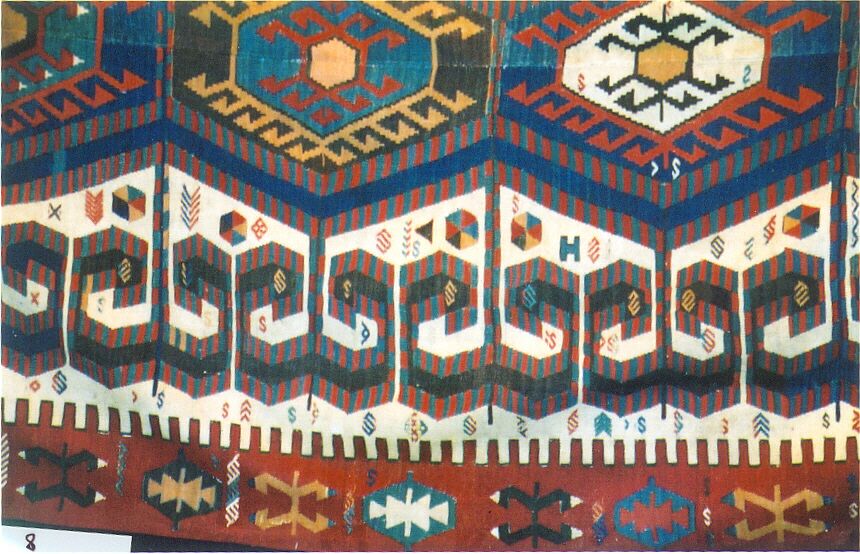
Rug Morning Session at The Textile Museum with Saul Barodofsky
On June 15, 2002, Saul Barodofsky,

one of those who has been presenting at TM rug mornings for many years, gave a "new collectors" presentation.
Saul, who as most of us know, has a rug shop in Charlottesville, VA is also one of the owner/managers of Turkotek.
He is a busy man, traveling frequently to Turkey and lots of other places (Russia in September!) to replenish his
stocks. (I have scanned photos from a rug morning session he gave two years ago for which I have not yet been able
to get a text.) This time we outsmarted him. I took the photos and Christine Brown, a regular, like myself, at
these Rug Mornings, took a good set of notes. Saul may have seen and made corrections in what follows, but any
errors are mine alone.
Saul, is a performer, with a definite "shtick." Harold Keshishian often says that he should have been
a vaudeville comedian. Saul was in his usual high form on June 15. He began by explaining that he is one of those
who does not think that only old material is interesting or collectible. He referenced the late Ralph Yohe, a well-known
collector and rug author from Wisconsin, who collected a large number of items, some of them seemingly without
great discrimination, and who bragged about the fact that he had never sold anything he had collected. Soooooo,
Saul said, this morning he would among other things, be showing us some of the pieces from his own "Ralph
Yohe" collection.
He began with a very unusual piece.

This piece, Saul said, was one commemorating the era of Attaturk. The figure in the small square is Attaturk
himself, the piece has a number of traditional Turkish symbols in it, including the Turkish flag, a hunting dog
or wolf and an agricultural scene inscribed with one of Attaturk's famous sayings, "The real masters of Turkey
are the peasantry." Although of no great age, this piece is well composed, colorful and full of interesting
features.
Next, Saul had several examples of a format not seen much and unusual to find in good condition. Saul's were genuinely
"old" pieces but in "new" condition.

These were examples of "Bergama cuvallari," a species of grain bag done in flatweave with brocade
decorations on the fronts. The examples he had were from the pre-synthetic era and some had the original bands
that are sewn on to them.
I personally find that the backs with their simple stripes (4) are frequently as attractive as the fronts.

In fact, the first such piece I owned is a back that I bought not knowing really what it was or what the front
looked like.
There is only one book devoted to these bags. It is "Bergama Cuvallari," by Doris Pinkwart and Elisabeth
Steiner. It has good color photos, with a text in German, but includes a short English summary by Josephine Powell.
Jerry Silverman and I have pointed out prevously that these are a group of "killer bags," so far rather
neglected by collectors.
Similar grain bags were woven in more eastern parts of Turkey. Saul had a pair, woven by Kurdish weavers in the
Malatya area.

Again, the condition of these old pieces was pristine.
Next Saul presented what he called a "butterfly" bag from Central Turkey.

Graphically very attractive with an interesting center band.
One hears frequently, Saul said, that all the old collectible material in Turkey is gone. Well, it may be less
frequently encountered but Saul brought evidence that this statement is not entirely true. Here is the first of
two kilims that he bought recently in Turkey.

This is a full kilim from Central Turkey. Saul estimated that it was made either in the late 18th or the early
19th century. The condition is excellent.
Here is a closer look at a detail of this piece.

The second full kilim that Saul bought recently is from the Turkish-Persian border. Azerbaijani. Karadagh?

Here is a closer detail of this piece. Saul said he likes all its asymmetries.

Bands are hard to photograph, but Saul had a horse neck trapping with a "dragon" design that I was able
to catch.

Piece (12) was an embroidered Uzbek saddle cover. Note two ties.
